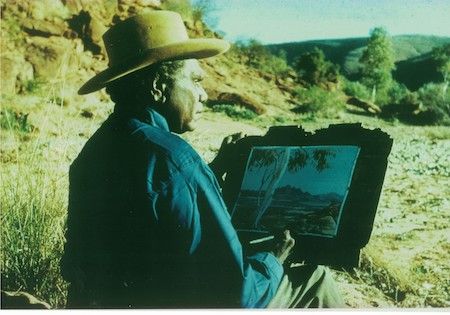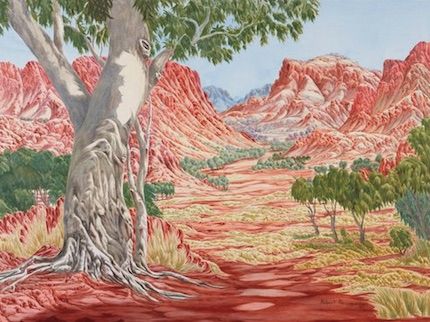Loading article…
Loading article…
4 October 2020
 By JOHN P McD SMITH
By JOHN P McD SMITH
This article has been updated, 6 October 2020, 12.00pm
It was in 1934 that Rex Battarbee and John Gardner exhibited their watercolour landscape paintings of the Western Mac Donnell Ranges in the schoolroom of the Hermannsburg Lutheran Mission.
Albert Namatjira was a young man of the Aranda tribe who lived at the mission and saw the paintings along with many other Aranda people.
This European style of art was a stark contrast to traditional Tjurunga dot and circle art work which represented Aranda culture and dreamtime.
Young Namatjira was mesmerised by what he saw that day.
He went and spoke with Battatbee indicating that he felt quite sure that he could do the same. There were some misgivings, but Namatjira insisted that he could paint in this manner.
Battarbee was intrigued and proceeded to show Namatjira how to work in the watercolour medium.
Namatjira then, under Battarbee’s guidance, went off and proceeded to sketch landscapes in the western Aranda lands and then used his natural ability to turn them into hauntingly beautiful watercolour landscape paintings.
His brush created paintings of mood, shade, light and perspective with an all-pervading sensitivity able to represent the subtle colours of the landforms of the Western Mac Donnells.
Aranda affinity with traditional tribal lands came through in Namatjira’s artistic portrayal of his ancestral heritage even though he was painting in the European style.
The Hermannsburg school of landscape painting was born.
Namatjira’s works became internationally known and sought after for this unique type of watercolour painting was done by a man who possessed a stirring natural talent. Namatjira’s first exhibition was held in Melbourne in 1938.
Namatjira’s sons, Oscar, Keith, Ewald and Maurice were soon painting in the same style and they were joined by the Pannkas, the Inkamalas, the Ebatarinjas, Kenneth Entata, Benjamin Landara, Henoch Rabaraba and Albert’s granddaughter, Jillian Namatjira.
All these artists were gifted in their own way but now they have all passed on and the Hermannsburg school has hardly any artists left.
[NOTE: We thank Mr Smith for his many valued contributions to the Alice Springs News, but the above statement and the arguments that follow do not reflect the current situation of the ‘Hermannsburg school’ of painters, as numerous articles on this site attest. See further clarification below.]
Perhaps the major reason for this has been the resurgence of traditional forms of Aboriginal art that began in the 1970’s with the appearance of the Western Desert school.
The asserting of many forms of Aboriginal culture in the present day has virtually rendered it unacceptable for Aboriginal people to continue to copy a European artistic style.
So now Aboriginal art is seen as representing the dimensions of the mythical dreamtime which is so important in all Aboriginal culture, and can only be painted in the time-honoured manner.
While Albert Namatjira’s works will always command fabulous prices those who want originals of his style now have to turn to the lesser representatives of the Hermannsburg school with the consequent result being that the prices for those works are on the increase.
It’s 60 years since Namatjira’s death and only now are others of his school coming into their own.
Perhaps the Hermannsburg school has been thrown a lifeline in the achievement of Vincent Namatjira who has won the 2020 prestigious Archibald Prize with his portrait of Adam Goodes (pictured at top).
He is the first indigenous Australian to win the Archibald Prize.
His works have been described as “caricatures”, which makes his paintings very different from the Hermannsburg school.
He is the great grandson of Albert Namatjira and yet his different art style perhaps heralds a new era in the world of Aboriginal art?
Image at top: Vincent Namatjira with his work, The Concrete Playgrounds. He is the first Indigenous artist to win the award in its 99-year history.
PHOTO of Albert Namatjira by AFP. The image is taken from a colour slide that the author’s father purchased in 1953 at Hermannsburg.
Note: John P McD Smith is the chair, St Francis’ House Project.
 On the same day as Vincent Namatjira was awarded the Archibald, Hubert Pareroultja, a leading present-day watercolourist in the Hermannsburg tradition, was announced as winner of the Wynne Prize, awarded annually by the Art Gallery of NSW for “the best landscape painting of Australian scenery”.
On the same day as Vincent Namatjira was awarded the Archibald, Hubert Pareroultja, a leading present-day watercolourist in the Hermannsburg tradition, was announced as winner of the Wynne Prize, awarded annually by the Art Gallery of NSW for “the best landscape painting of Australian scenery”.
His winning work, Tjoritja (West MacDonnell Ranges, NT), is illustrated above (source, AGNSW).
Pareroultja has previously been a finalist in the National Aboriginal and Torres Strait Islander Awards; has works in major public art collections; has had several solo exhibitions and participated in numerous group shows around Australia.
He is a core artist of the small but thriving Iltja Ntjarra Many Hands Art Centre, with a busy program of exhibitions, creative projects and commissions year round until the rude interruption of Covid-19. For example, Pareroultja joined with 11 others to take part in this year’s Sydney Biennale. They were: Kathleen France, Noreen Hudson, Clara Inkamala, Dellina Inkamala, Kathy Inkamala, Reinhold Inkamala, Vanessa Inkamala, Janie Karpa, the late G. Pannka, Ivy Pareroultja, Mervyn Rubuntja, and Hillary Wirri.
–Kieran Finnane